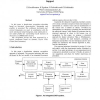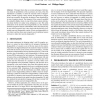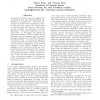25 search results - page 5 / 5 » Finite State Automata Representing Two-Dimensional Subshifts |
ICDAR
2003
IEEE
14 years 22 days ago
2003
IEEE
In this paper a handwritten recognition algorithm based on structural characteristics, histograms and profiles, is presented. The well-known horizontal and vertical histograms are...
CODES
2010
IEEE
13 years 5 months ago
2010
IEEE
Synchronous Dataflow (SDF) is a powerful analysis tool for regular, cyclic, parallel task graphs. The behaviour of SDF graphs however is static and therefore not always able to ac...
ECAI
2008
Springer
13 years 9 months ago
2008
Springer
Abstract. This paper shows that we can take advantage of information about the probabilities of the occurrences of events, when this information is available, to refine the classic...
IJCAI
1997
13 years 8 months ago
1997
Propositional STRIPS planning problems can be viewed as finite state automata (FSAs) represented in a factored form. Automaton minimization is a well-known technique for reducing ...
WIA
2001
Springer
13 years 12 months ago
2001
Springer
A formal device is said to be adaptive whenever its behavior changes dynamically, in a direct response to its input stimuli, without interference of external agents, even its user...



